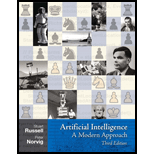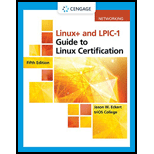
Artificial Intelligence: A Modern Approach
3rd Edition
ISBN: 9780136042594
Author: Stuart Russell, Peter Norvig
Publisher: Prentice Hall
expand_more
expand_more
format_list_bulleted
Expert Solution & Answer
Chapter 7, Problem 13E
a.
Explanation of Solution
Clause
- P ⇒ Q is equivalent to ¬P ∨Q by implication elimination.
- ¬(P1 ∧· · · ∧ Pm) is equivalent to (¬P1 ∨ · ...
b.
Explanation of Solution
Clause
- A clause can have positive and negative literals.
- Let the negative literals have the form¬P1, . . . ,¬Pm and let the positive literals have the form Q1, . . . ,Qn, where the Pis and Qjs are symbols.
- Then the clause can be written as (¬P1 ∨· &#x...
c.
Explanation of Solution
Full resolution rule
- For atoms pi, qi, ri, si, then pj = qk:
- Then the full resolution rule is
p1 ∧ . . . pj . . . ∧ pn1 ⇒ r1 ∨ . . . rn2
s1 ∧ ...
Want to see the full answer?
Check out a sample textbook solution
Students have asked these similar questions
Benefits of using arrays as instance variables: What are the advantages of incorporating arrays as instance variables within a class?
Initializing and managing arrays: How do you initialize and manage arrays within class constructors and mutators (setters)?
Example of using arrays as instance variables: Share an example where you have used arrays as instance variables and discuss its application in a real-world scenario.
Common mistakes with arrays as instance variables: What are some common mistakes to avoid when working with arrays as instance variables?
Information hiding violations: What is the potential violation of information hiding when using arrays as instance variables? How can this be resolved?
Do you think that computers should replace teachers? Give three references with your answer.
Is online learning or face to face learning better to teach students around the around the world? Give reasons for your answer and provide two references with your response.
What are benefits of both online learning and face to face learning ? Give two references with your answer.
How does online learning and face to face learning affects students around the world? Give two references with your answer.
Chapter 7 Solutions
Artificial Intelligence: A Modern Approach
Ch. 7 - Suppose the agent has progressed to the point...Ch. 7 - (Adapted from Barwise and Etchemendy (1993).)...Ch. 7 - Prob. 3ECh. 7 - Which of the following are correct? a. False |=...Ch. 7 - Prob. 5ECh. 7 - Prob. 6ECh. 7 - Prob. 7ECh. 7 - We have defined four binary logical connectives....Ch. 7 - Prob. 9ECh. 7 - Prob. 10E
Ch. 7 - Prob. 11ECh. 7 - Prob. 12ECh. 7 - Prob. 13ECh. 7 - Prob. 14ECh. 7 - Prob. 15ECh. 7 - Prob. 16ECh. 7 - Prob. 17ECh. 7 - Prob. 18ECh. 7 - A sentence is in disjunctive normal form (DNF) if...Ch. 7 - Prob. 20ECh. 7 - Prob. 21ECh. 7 - Prob. 23ECh. 7 - Prob. 24ECh. 7 - Prob. 25ECh. 7 - Prob. 26ECh. 7 - Prob. 27E
Knowledge Booster
Similar questions
- Explain Five reasons if computers should replace teachers. Provide three references with your answer. List three advantages and three disadvantages face to face learning and online learning may have on children. Provide two references with your answer.arrow_forwardYou were requested to design IP addresses for the following network using the address block 10.10.10.0/24. Specify an address and net mask for each network and router interfacearrow_forwardFor the following network, propose routing tables in each of the routers R1 to R5arrow_forward
- How can I type the Java OOP code by using JOptionPane with this following code below: public static void sellCruiseTicket(Cruise[] allCruises) { //Type the code here }arrow_forwardDraw a system/level-0 diagram for this scenario: You are developing a new customer relationship management system for the BEC store, which rents out movies to customers. Customers will provide comments on new products, and request rental extensions and new products, each of which will be stored into the system and used by the manager for purchasing movies, extra copies, etc. Each month, one employee of BEC will select their favorite movie pick of that week, which will be stored in the system. The actual inventory information will be stored in the Entertainment Tracker system, and would be retrieved by this new system as and when necessary. Example of what a level-0 diagram looks like is attached.arrow_forwardWhat is the value of performing exploratory data analysis in designing data visualizations? What are some examples?arrow_forward
- Draw a level-0 diagram for this scenario: You are developing a new customer relationship management system for the BEC store, which rents out movies to customers. Customers will provide comments on new products, and request rental extensions and new products, each of which will be stored into the system and used by the manager for purchasing movies, extra copies, etc. Each month, one employee of BEC will select their favorite movie pick of that week, which will be stored in the system. The actual inventory information will be stored in the Entertainment Tracker system, and would be retrieved by this new system as and when necessary.arrow_forwardDraw a context diagram for this scenario: You are developing a new customer relationship Management system for the BEC store, which rents out movies to customers. Customers will provide comments on new products, and request rental extensions and new products, each of which will be stored into the system and used by the manager for purchasing movies, extra copies, etc. Each month, one employee of BEC will select their favorite movie pick of that week, which will be stored in. the system. The actual inventory information will be stored in the Entertainment Tracker system, and would be retrieved by this new system as and when necessary.arrow_forwardWrite a complete Java program named FindSumAndAverage that performs the following tasks in 2-D array: Main Method: a. The main() method asks the user to provide the dimension n for a square matrix. A square matrix has an equal number of rows and columns. b. The main() method receives the value of n and calls the matrixSetUp() method that creates a square matrix of size n and populates it randomly with integers between 1 and 9. c. The main method then calls another method named printMatrix() to display the matrix in a matrix format. d. The main method also calls a method named findSumAndAverage() which: • Receives the generated matrix as input. • Calculates the sum of all elements in the matrix. • Calculates the average value of the elements in the matrix. • Stores these values (sum and average) in a single-dimensional array and returns this array • e. The main method prints the sum and average based on the result returned from findSumAndAverage()). Enter the dimension n for the square…arrow_forward
arrow_back_ios
SEE MORE QUESTIONS
arrow_forward_ios
Recommended textbooks for you
 LINUX+ AND LPIC-1 GDE.TO LINUX CERTIF.Computer ScienceISBN:9781337569798Author:ECKERTPublisher:CENGAGE L
LINUX+ AND LPIC-1 GDE.TO LINUX CERTIF.Computer ScienceISBN:9781337569798Author:ECKERTPublisher:CENGAGE L C++ Programming: From Problem Analysis to Program...Computer ScienceISBN:9781337102087Author:D. S. MalikPublisher:Cengage Learning
C++ Programming: From Problem Analysis to Program...Computer ScienceISBN:9781337102087Author:D. S. MalikPublisher:Cengage Learning C++ for Engineers and ScientistsComputer ScienceISBN:9781133187844Author:Bronson, Gary J.Publisher:Course Technology Ptr
C++ for Engineers and ScientistsComputer ScienceISBN:9781133187844Author:Bronson, Gary J.Publisher:Course Technology Ptr- Programming Logic & Design ComprehensiveComputer ScienceISBN:9781337669405Author:FARRELLPublisher:Cengage
 Operations Research : Applications and AlgorithmsComputer ScienceISBN:9780534380588Author:Wayne L. WinstonPublisher:Brooks ColeNp Ms Office 365/Excel 2016 I NtermedComputer ScienceISBN:9781337508841Author:CareyPublisher:Cengage
Operations Research : Applications and AlgorithmsComputer ScienceISBN:9780534380588Author:Wayne L. WinstonPublisher:Brooks ColeNp Ms Office 365/Excel 2016 I NtermedComputer ScienceISBN:9781337508841Author:CareyPublisher:Cengage

LINUX+ AND LPIC-1 GDE.TO LINUX CERTIF.
Computer Science
ISBN:9781337569798
Author:ECKERT
Publisher:CENGAGE L

C++ Programming: From Problem Analysis to Program...
Computer Science
ISBN:9781337102087
Author:D. S. Malik
Publisher:Cengage Learning

C++ for Engineers and Scientists
Computer Science
ISBN:9781133187844
Author:Bronson, Gary J.
Publisher:Course Technology Ptr

Programming Logic & Design Comprehensive
Computer Science
ISBN:9781337669405
Author:FARRELL
Publisher:Cengage

Operations Research : Applications and Algorithms
Computer Science
ISBN:9780534380588
Author:Wayne L. Winston
Publisher:Brooks Cole

Np Ms Office 365/Excel 2016 I Ntermed
Computer Science
ISBN:9781337508841
Author:Carey
Publisher:Cengage